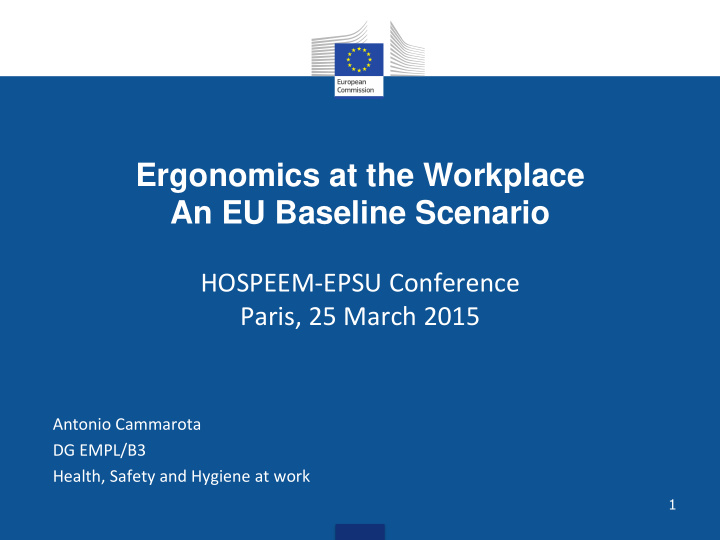



Ergonomics at the Workplace An EU Baseline Scenario HOSPEEM-EPSU Conference Paris, 25 March 2015 Antonio Cammarota DG EMPL/B3 Health, Safety and Hygiene at work 1
What is the matter? • Ergonomic related risks: One of the major OSH problems in Europe Responsible for WRMSDs Affect both women and men and all sectors of activity across the European Union A major cost burden for business and society 2
What is the matter? • WRMSDs represent today more than 60% of all work- related health problems • Account for 60% of all sickness absences in the EU and also for about 60% of all cases of permanent incapacity to work • At least 11m workers are affected, i.e. 5% of the total EU working population • Higher prevalence among manual workers in industry 3
What is the matter? • Total cost of WRMSDs across the EU can be estimated at over EUR 163bn • main cost drivers are productivity losses incurred by employers (EUR 48bn) • and health-related quality of life losses incurred by workers (EUR 99bn) 4
What is the matter? • Impact of costs by stakeholders Workers the most affected: 65% of total costs Employers: 33% Public authorities: 2.2% 5
What is the matter? • Increasing trend in prevalence of WRMSDs in most Member States – Results from the 2009 Scoreboard of the EU OSH Strategy Decreasing rates in only 5 MS 2 MS show stable rates The remaining MS show consistently increasing trends 6
The EU legal framework • "Framework" Directive 89/391/EEC ( Article 6.2d states the ergonomic principle of "adapting the work to the individual" • Directive 90/269/EEC (manual handling of loads) • Directive 90/270/EEC (work with display screen equipment) • Directive 2002/44/EC (vibration) 7
The EU legal framework • Directive 89/654/EEC (workplace) • Directive 89/655/EEC (work equipment) • Directive "machinery" (most recently 2006/42/EC, recast of 95/16/EC) – intended to ensure a common safety level in machinery places on the market or put in service in the MSs 8
Non-regulatory initiatives • EU-OSHA Campaigns (2000 & 2007) • 2007-2008 SLIC Campaign on enforcement of the "manual handling of loads"-Directive (health care, transport, construction, retail sectors) • Several initiatives at national level 9
Future trends • Demographic change (there is a positive correlation between a worker’s age and the likelihood of reporting a work-related health problem) • Changes in the sectorial composition of European economies (increasing share of people working in services) • Different prevalence in exposure to risks (repetitive work as the most important risk factor) • Limited focus of existing legislation (significant part of problems likely not to be properly addressed; provisions on DSE partly outdated) 10
Conclusions • In line with the principles of subsidiarity and proportionality, any future EU action needs to refrain from duplicating initiatives at national level or from imposing superfluous additional requirements beyond the principles laid down in the "Framework" Directive 89/391/EEC 11
Conclusions • Keeping in mind broad EU competences and a well- developed legislative framework in the area of occupational health and safety, the proposed changes should instead focus on: Improving the effectiveness of the EU regulatory framework, and Exploring ways of simplifying existing requirements 12
Conclusions • The Commission is in the process of evaluating the OSH legislative framework (24 Directives), with a view to identifying ways to make legislation fitter for purpose and improving conditions for better implementation of OSH provisions 13
• Thank you for attention! 14
Recommend
More recommend